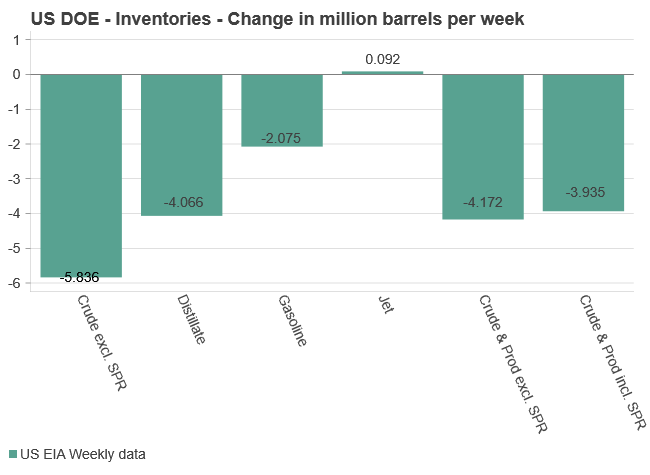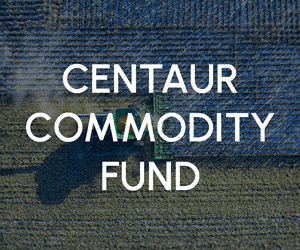Analys
Market on Edge Awaiting Israel’s Next Move Against Iran

Brent crude jumped as much as 5.5% yesterday before it closed at USD 77.62/b (+5%). That is up USD 9/b since the recent low-point of USD 68.68/b on 10 Sep which was the lowest Brent price since December 2021. The jump yesterday was fueled by Biden saying that attacks on Iranian oil infrastructure was under discussion as a response to the 200 ballistic missiles Iran fired at Israel on Tuesday. Brent price this morning is mostly unchanged.

While we have seen a strong rebound in the oil price lately, the current price of USD 77.6/b is still below its close in August of USD 78.8/b and also well below the USD 80-85/b where Brent has comfortably been trading for more than 18 months. One should think that the latest escalation in the Middle East would have forced some short-covering of more than 250 mb of short oil positions in Brent and WTI. But so far at least not enough to spur Brent crude back to USD 80/b.
It is now almost one year since the Oct 7 attack on Israel. And so far the market has not lost a single drop of oil. The most severe impact on the oil market so far is the rerouting of oil around Africa due to Houthis firing rockets at ships in the Red Sea.
While Mid-East tensions are running high, the oil market is still deeply concerned about weak demand and a surplus oil in 2025. OPEC+ this week again confirmed that they will lift production by 180 kb/d in December. The plan is for a monthly increase by this amount for 12 months to November 2025. But even if they do lift production in December, it doesn’t necessarily mean that they will lift also in January. That remains to be decided. Saudi Arabia is clearly frustrated by the fact that Iraq, Kazakhstan and Russia haven’t complied fully with agreed quotas. And if your teammates do not play by the agreed rules, then how can you keep on playing. But they still have October and November to show that they are good palls.
Libya is also set to revive production in the coming days. Its production tumbled to less than 450 kb/d in August and averaged 600 kb/d in September. It will likely return back to around 1.2 mb/d rather quickly as internal political disagreements have been ironed out for now.
Ahead of us however is still the retaliatory attack by Iran on Israel. All options are probably weighted and Israel naturally have a long list of possible targets already made out. Which to choose? Oil installations? Other economic targets? Military installations? Nuclear facilities?,.. It is a fine balance. A forceful retaliation, but not so strong that it leads to an uncontrollable tit-for-tat escalation. Israel may utilize the situation to hit Iranian nuclear installations now that Hezbollah is partially sidelined.
Our expectations are that the Israeli retaliation will come rather quickly and probably before Oct 7. It probably won’t hit oil installations. Most likely it will hit military installations. Possibly Iran’s nuclear facilities. But if the later are hit then we are in for a real tit-for-tat escalation.
If all of Iran’s oil export capacity was to be taken out, then the world would lose around 1.7 mb/d of Iranian crude oil exports plus some 0.5 mb/d of condensate exports. OPEC+ now holds a spare capacity of 5-6 mb/d with Saudi Arabia alone able to lift production by 2-3 mb/d. UAE, Iraq and Kuwait can probably lift production by 1.5 to 2.0 mb/d and Russia by 1.0 mb/d. So world would not go dry for oil even if Iran’s oil exports are fully taken out. But spare capacity would be much lower and that would lift the oil price higher. But if Iran’s exports were taken out then we are talking full turmoil around the Strait of Hormuz. And the oil price would jump considerably and above USD 100/b as the risk of further escalation which might impact exports out of the Strait of Hormuz which carries close to 20% of all oil consumed in the world.
The rule of thumb in commodity markets is that if supply is severely restricted then the price will often spike to 5-10x its normal level. Most recent examples of this is global LNG prices which spiked to USD 385/boe when Russia chocked off gas supplies to Europe. So if worst came to worst and the Strait of Hormuz was closed for a month or more then Brent crude would likely spike to USD 350/b, the world economy would crater and the oil price would fall back to below USD 200/b again over some time. But the risk for this currently seems very remote and both the US and China would likely move in to try to reopen the Strait if it was closed. But when rockets are flying left, right and center, it is not so easy. But seeing where the oil price sits right now the market doesn’t seem to hold much probability for such a development at all.
But it is not so long ago that world markets were taken completely off-guard by the developments in Russia/Ukraine. So while probabilities for worst case scenarios are very low, everyone are still biting nails for what will happen the coming days as we await the retaliatory attack by Israel on Iran.
Analys
Tightening fundamentals – bullish inventories from DOE

The latest weekly report from the US DOE showed a substantial drawdown across key petroleum categories, adding more upside potential to the fundamental picture.

Commercial crude inventories (excl. SPR) fell by 5.8 million barrels, bringing total inventories down to 415.1 million barrels. Now sitting 11% below the five-year seasonal norm and placed in the lowest 2015-2022 range (see picture below).
Product inventories also tightened further last week. Gasoline inventories declined by 2.1 million barrels, with reductions seen in both finished gasoline and blending components. Current gasoline levels are about 3% below the five-year average for this time of year.
Among products, the most notable move came in diesel, where inventories dropped by almost 4.1 million barrels, deepening the deficit to around 20% below seasonal norms – continuing to underscore the persistent supply tightness in diesel markets.
The only area of inventory growth was in propane/propylene, which posted a significant 5.1-million-barrel build and now stands 9% above the five-year average.
Total commercial petroleum inventories (crude plus refined products) declined by 4.2 million barrels on the week, reinforcing the overall tightening of US crude and products.


Analys
Bombs to ”ceasefire” in hours – Brent below $70

A classic case of “buy the rumor, sell the news” played out in oil markets, as Brent crude has dropped sharply – down nearly USD 10 per barrel since yesterday evening – following Iran’s retaliatory strike on a U.S. air base in Qatar. The immediate reaction was: “That was it?” The strike followed a carefully calibrated, non-escalatory playbook, avoiding direct threats to energy infrastructure or disruption of shipping through the Strait of Hormuz – thus calming worst-case fears.

After Monday morning’s sharp spike to USD 81.4 per barrel, triggered by the U.S. bombing of Iranian nuclear facilities, oil prices drifted sideways in anticipation of a potential Iranian response. That response came with advance warning and caused limited physical damage. Early this morning, both the U.S. President and Iranian state media announced a ceasefire, effectively placing a lid on the immediate conflict risk – at least for now.
As a result, Brent crude has now fallen by a total of USD 12 from Monday’s peak, currently trading around USD 69 per barrel.
Looking beyond geopolitics, the market will now shift its focus to the upcoming OPEC+ meeting in early July. Saudi Arabia’s decision to increase output earlier this year – despite falling prices – has drawn renewed attention considering recent developments. Some suggest this was a response to U.S. pressure to offset potential Iranian supply losses.
However, consensus is that the move was driven more by internal OPEC+ dynamics. After years of curbing production to support prices, Riyadh had grown frustrated with quota-busting by several members (notably Kazakhstan). With Saudi Arabia cutting up to 2 million barrels per day – roughly 2% of global supply – returns were diminishing, and the risk of losing market share was rising. The production increase is widely seen as an effort to reassert leadership and restore discipline within the group.
That said, the FT recently stated that, the Saudis remain wary of past missteps. In 2018, Riyadh ramped up output at Trump’s request ahead of Iran sanctions, only to see prices collapse when the U.S. granted broad waivers – triggering oversupply. Officials have reportedly made it clear they don’t intend to repeat that mistake.
The recent visit by President Trump to Saudi Arabia, which included agreements on AI, defense, and nuclear cooperation, suggests a broader strategic alignment. This has fueled speculation about a quiet “pump-for-politics” deal behind recent production moves.
Looking ahead, oil prices have now retraced the entire rally sparked by the June 13 Israel–Iran escalation. This retreat provides more political and policy space for both the U.S. and Saudi Arabia. Specifically, it makes it easier for Riyadh to scale back its three recent production hikes of 411,000 barrels each, potentially returning to more moderate increases of 137,000 barrels for August and September.
In short: with no major loss of Iranian supply to the market, OPEC+ – led by Saudi Arabia – no longer needs to compensate for a disruption that hasn’t materialized, especially not to please the U.S. at the cost of its own market strategy. As the Saudis themselves have signaled, they are unlikely to repeat previous mistakes.
Conclusion: With Brent now in the high USD 60s, buying oil looks fundamentally justified. The geopolitical premium has deflated, but tensions between Israel and Iran remain unresolved – and the risk of missteps and renewed escalation still lingers. In fact, even this morning, reports have emerged of renewed missile fire despite the declared “truce.” The path forward may be calmer – but it is far from stable.
Analys
A muted price reaction. Market looks relaxed, but it is still on edge waiting for what Iran will do

Brent crossed the 80-line this morning but quickly fell back assigning limited probability for Iran choosing to close the Strait of Hormuz. Brent traded in a range of USD 70.56 – 79.04/b last week as the market fluctuated between ”Iran wants a deal” and ”US is about to attack Iran”. At the end of the week though, Donald Trump managed to convince markets (and probably also Iran) that he would make a decision within two weeks. I.e. no imminent attack. Previously when when he has talked about ”making a decision within two weeks” he has often ended up doing nothing in the end. The oil market relaxed as a result and the week ended at USD 77.01/b which is just USD 6/b above the year to date average of USD 71/b.

Brent jumped to USD 81.4/b this morning, the highest since mid-January, but then quickly fell back to a current price of USD 78.2/b which is only up 1.5% versus the close on Friday. As such the market is pricing a fairly low probability that Iran will actually close the Strait of Hormuz. Probably because it will hurt Iranian oil exports as well as the global oil market.
It was however all smoke and mirrors. Deception. The US attacked Iran on Saturday. The attack involved 125 warplanes, submarines and surface warships and 14 bunker buster bombs were dropped on Iranian nuclear sites including Fordow, Natanz and Isfahan. In response the Iranian Parliament voted in support of closing the Strait of Hormuz where some 17 mb of crude and products is transported to the global market every day plus significant volumes of LNG. This is however merely an advise to the Supreme leader Ayatollah Ali Khamenei and the Supreme National Security Council which sits with the final and actual decision.
No supply of oil is lost yet. It is about the risk of Iran closing the Strait of Hormuz or not. So far not a single drop of oil supply has been lost to the global market. The price at the moment is all about the assessed risk of loss of supply. Will Iran choose to choke of the Strait of Hormuz or not? That is the big question. It would be painful for US consumers, for Donald Trump’s voter base, for the global economy but also for Iran and its population which relies on oil exports and income from selling oil out of that Strait as well. As such it is not a no-brainer choice for Iran to close the Strait for oil exports. And looking at the il price this morning it is clear that the oil market doesn’t assign a very high probability of it happening. It is however probably well within the capability of Iran to close the Strait off with rockets, mines, air-drones and possibly sea-drones. Just look at how Ukraine has been able to control and damage the Russian Black Sea fleet.
What to do about the highly enriched uranium which has gone missing? While the US and Israel can celebrate their destruction of Iranian nuclear facilities they are also scratching their heads over what to do with the lost Iranian nuclear material. Iran had 408 kg of highly enriched uranium (IAEA). Almost weapons grade. Enough for some 10 nuclear warheads. It seems to have been transported out of Fordow before the attack this weekend.
The market is still on edge. USD 80-something/b seems sensible while we wait. The oil market reaction to this weekend’s events is very muted so far. The market is still on edge awaiting what Iran will do. Because Iran will do something. But what and when? An oil price of 80-something seems like a sensible level until something do happen.
-

 Nyheter3 veckor sedan
Nyheter3 veckor sedanStor uppsida i Lappland Guldprospekterings aktie enligt analys
-

 Nyheter4 veckor sedan
Nyheter4 veckor sedanBrookfield ska bygga ett AI-datacenter på hela 750 MW i Strängnäs
-

 Nyheter4 veckor sedan
Nyheter4 veckor sedanSommaren inleds med sol och varierande elpriser
-

 Nyheter3 veckor sedan
Nyheter3 veckor sedanSilverpriset släpar efter guldets utveckling, har mer uppsida
-

 Nyheter4 veckor sedan
Nyheter4 veckor sedanOPEC+ ökar oljeproduktionen trots fallande priser
-

 Analys4 veckor sedan
Analys4 veckor sedanBrent needs to fall to USD 58/b to make cheating unprofitable for Kazakhstan
-

 Nyheter4 veckor sedan
Nyheter4 veckor sedanTradingfirman XTX Markets bygger datacenter i finska Kajana för 1 miljard euro
-

 Nyheter2 veckor sedan
Nyheter2 veckor sedanUppgången i oljepriset planade ut under helgen









